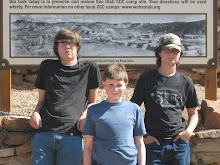Questions
Q: Was Utahraptor warm-blooded or cold-blooded?
A: This is one of the toughest questions asked by paleontologists; were dinosaurs warm-blooded or cold-blooded? In retrospect, I think they were both warm and cold-blooded. Predators like Allosaurus had to be warm-blooded so they could catch their prey in the early morning, which is when they usually liked to hunt. Now, in the case of Utahraptor and other dromaeosaurs, I think they were warm-blooded because they could run fairly quickly. Plus, they might have been nocturnal, which means they hunted at night. Night was the coldest time, and its prey was probably not very fast at night.
Q: How did Utahraptor die out?
A: Utahraptor probably died because of the changing environment. You have to remember; it lived in the early Cretaceous. Earth was cooling down. Utahraptor had probably been adapted to a warmer and drier climate. Once the climate became somewhat cooler and wetter, this caused Utahraptors everywhere to die.
Q: How old did Utahraptor get before it died?
A: That’s a very good question. I’m not entirely sure, but I think it could probably be up to 65-70 years old, based on modern-day life spans of creatures it is related to.
Q: How long did Utahraptor live before they became extinct?
A: Utahraptor lived about 5 million years before they became extinct.
Habitat
Utahraptor packs probably lived in forests or deserts/prairies where hunting wouldn’t be a problem. They probably had a certain amount of territory, probably up to 3 miles in all directions, and part of their territory could have been near a water source, such as a lake, river, or stream. This suggests, but does not prove, that Utahraptor ate fish as part of its regular diet. The following descriptions are of the habitats of Utahraptor.
Forest
In the forest, Utahraptor would probably have hunted rodent-like creatures and lizards. The forest is probably where they would put their nests. Utahraptor packs guarded their nests very well. They would leave one or two guards behind while the rest of the pack hunts. Then, they would probably bring back some leftovers for the guards. Forest Utahraptors would have been rare, since at that time, the landscape was mostly barren desert, with very few forests.
Deserts/Prairies
The desert/prairie was probably where Utahraptor did most of its hunting when it comes to big game. They would try to separate a young or weak creature from the rest of its herd, then they would kill the separated creature. Often, the prey animal wouldn’t be enough to supply all Utahraptor with food. Therefore, there were probably feeding frenzies, in which some of the members of the pack may have been injured or killed.
Saturday, November 13, 2010
Subscribe to:
Posts (Atom)
